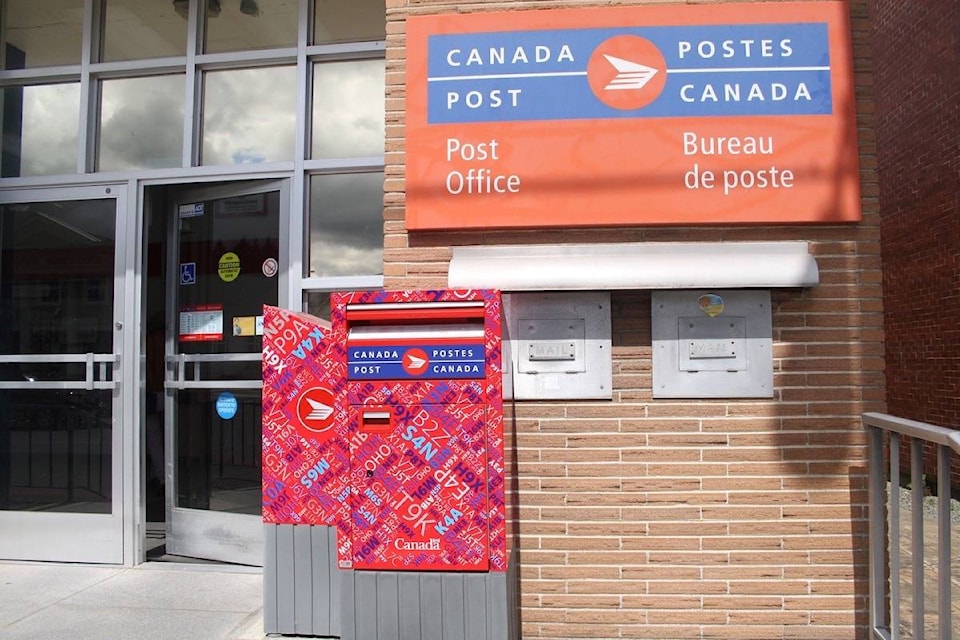In December 1939, passersby on Station Street were startled to see two “ponderous carved wooden ornaments…which look something like chess men with conical caps”. —Cowichan Leader.
Had occasion to address the Cowichan Valley Stamp Club last week and in rummaging through my archives for a suitable topic resolved upon Duncan’s postal history. Specifically, its post offices, of which we’ve had six in just over a century.
The first was in J. MacDonald’s home and/or business at Craig and Government streets, the second in W.P. Jaynes’ store at the southwest corner of Station and Front streets (today’s Canada Avenue), 1893-1900. But there’s some confusion here. The 1893 incarnation, reputedly only 12 by 14 feet, also is said to have been built by D.R. Hattie for David Ford, who was Duncan Postmaster, 1900-1931. (This would be on the site of today’s Hudson Block across Station Street from Jaynes’s store.)
This isn’t absolutely certain and former Cowichan Valley Museum curator Priscilla Lowe wonders: “1900 is the date Ford became postmaster. Is it possible D.R. Hattie built it in 1900, not 1893, or did Jaynes actually run it out of that building, not his store, from 1893-1900?”
In 1908, the Cowichan Leader crowed of a new post office (this one the city’s fourth, and definitely sited on the same Station Street lot as the third post office), “Duncan [is] becoming the Chicago of Vancouver Island”. Ford, then in his eighth year as postmaster, was praised for his “enterprise and faith” in the city’s future. His brother Walter had the contract for building this post office of two storeys, 50 by 52 (2,600 square feet), with a basement. The ground floor was to be divided in two, a store to occupy one half, with offices upstairs. The post office, 29 by 50 feet, “is very nicely laid out, will have lots of room, and will be fitted with all the modern appliances for the handling of the mails and for the convenience of the public… The building will be fitted with modern lavratories [sic], and will be heated by a furnace, a large septic tank will be built, and everything will be completed in first class shape.
“The present building will be moved to the back of the lot during construction.”
Four months later, again in the words of the Leader, “The people of Duncan now have a post office of which they may well feel proud of, being large and convenient and the fittings in the interior being of a most elaborate nature. The [200] new post office boxes…are of the very latest pattern and fitted with patent combination locks which will prevent any trouble through the owner losing the key — provided he does not forget the combination. Printed cards are displayed around the wall, warning the public to, ‘Post no bills,’ while a blackboard has been provided ‘For official notices only.’” Lighting was by acetylene gas.
In December 1939, G.P. MacMillan, secretary of the Duncan Chamber of Commerce, made news when he was seen driving down Station Street with two “ponderous carved wooden ornaments… Relics of the day when architects indulged in flourishes, the ornaments, which look something like chess men with conical caps, were removed a year or two ago because Mr. Walter Hudson [owner] considered them unstable and a danger to passers-by…
“[They] were placed on top of the building when Mr. David Ford constructed it as a post office in 1908. Postmaster and contractor, too, he had previously sorted the mail for eight years in the small building behind, which is now the home of Mr. James Tonkin.”
For months the carvings, by this time described as being rather pathetic objects, had stood on the ground behind the Greenhaven Restaurant until MacMillan carted them away. He admitted that he wasn’t sure what he was going to do with them, and half-joked that he could always use them for kindling. Three-quarters of a century later, we have to wonder if these historic icons did indeed go into the fire.
During demolition of the Overwaitea Store on Craig Street, in June 1942, passers-by were reportedly surprised to see a “small, square, brown-coloured” cottage come into view behind the Overwaitea and the Emporium Building (the demolished Red Balloon building).
Newspaper reports told how, in 1908, David Ford had his brother Walter move the small structure, which apparently doubled as his home and office, back on the lot to allow for the construction of the 2,500-square-foot Ford Building, which became known as the Post Office Block, today’s Hudson Block.
In so doing, David Ford had, in the Leader’s view, demonstrated his “enterprise and faith in the Island and the Island city of which he has been postmaster for about seven years past…”
(To be continued)
